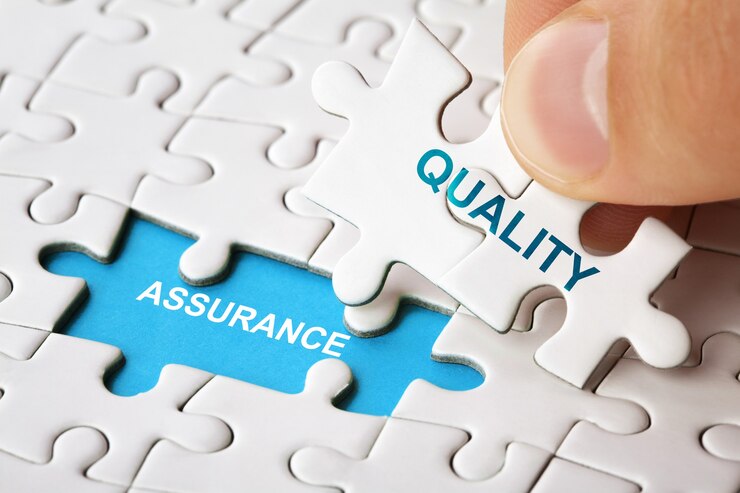- FREE Express Shipping On Orders $99+

Embark on the Quest for Excellence: Attain the Prestigious ISO 9001 Certification
I. Introduction
A. Setting the Stage: The Pursuit of Excellence in Quality Management
In today’s hyper-competitive business landscape, the pursuit of excellence in quality management has become more crucial than ever before. Quality management encompasses the processes, systems, and practices that organizations employ to ensure their products or services consistently meet or exceed customer expectations. From manufacturing to service industries, organizations across various sectors strive to achieve excellence in quality management as a key driver of success.
The significance of quality management lies not only in meeting regulatory requirements but also in enhancing customer satisfaction, improving operational efficiency, and driving continuous improvement. Organizations that prioritize quality management demonstrate their commitment to delivering value to customers, building strong reputations, and sustaining long-term success in the marketplace.
B. Unveiling ISO 9001 Certification: A Symbol of Prestige and Quality Assurance

At the forefront of quality management standards stands ISO 9001 certification, widely regarded as the gold standard for quality assurance. ISO 9001 is a globally recognized quality management system (QMS) standard developed by the International Organization for Standardization (ISO). It provides a framework for organizations to establish, implement, maintain, and continually improve their quality management systems.
ISO 9001 certification serves as a symbol of prestige and quality assurance, signifying that an organization has met the stringent requirements of the ISO 9001 standard. Achieving ISO 9001 certification demonstrates an organization’s commitment to quality, customer satisfaction, and continuous improvement. It instills confidence in customers, stakeholders, and business partners, showcasing an organization’s ability to consistently deliver products or services that meet the highest standards of quality and reliability.
In the following sections, we will delve deeper into the world of ISO 9001 certification, exploring its significance, benefits, processes, and implications for organizations committed to achieving excellence in quality management. Join us on this journey as we uncover the keys to unlocking ISO 9001 certification and elevating your organization to new heights of success and distinction.
II. Understanding ISO 9001 Certification
A. Decoding ISO 9001: What Makes It Stand Out?
ISO 9001 is more than just a quality management standard; it’s a framework designed to help organizations achieve excellence in their operations. At its core, ISO 9001 emphasizes a customer-centric approach, focusing on meeting customer requirements and enhancing satisfaction. What sets ISO 9001 apart is its emphasis on continuous improvement, risk-based thinking, and process-based management. By adopting ISO 9001, organizations commit to a systematic approach to quality management, driving efficiency, consistency, and effectiveness throughout their operations.
B. Demystifying the ISO 9001 Certification Process
The ISO 9001 certification process can seem daunting at first, but breaking it down into manageable steps can make it more approachable. It typically involves several key stages, including preparation, documentation, implementation, internal audits, and certification audits. Preparation involves familiarizing oneself with the requirements of ISO 9001 and identifying any gaps in current practices. Documentation entails creating a quality manual, procedures, and records to demonstrate compliance. Implementation involves putting these documented processes into action, while internal audits ensure that everything is running smoothly. Finally, the certification audit, conducted by an accredited certification body, assesses the organization’s compliance with ISO 9001 standards and grants certification upon successful demonstration of conformity.
C. Evolution of ISO 9001: From Standards to Global Recognition
Since its inception, ISO 9001 has evolved from a set of standards to a globally recognized benchmark for quality management. Originally developed in 1987, ISO 9001 has undergone several revisions to keep pace with changing business environments and emerging trends. The most recent version, ISO 9001:2015, places greater emphasis on risk-based thinking, leadership engagement, and stakeholder focus. This evolution reflects ISO’s commitment to ensuring that ISO 9001 remains relevant and effective in addressing the evolving needs of organizations worldwide. Today, ISO 9001 certification is not just a badge of honor; it’s a testament to an organization’s dedication to quality, customer satisfaction, and continuous improvement.
III. The Significance of ISO 9001 Certification
A. Elevating Organizational Performance: The Impact of ISO 9001 Certification
ISO 9001 certification serves as a catalyst for elevating organizational performance to new heights. By implementing the principles and practices outlined in the ISO 9001 standard, organizations can enhance their efficiency, effectiveness, and overall performance. ISO 9001 promotes a systematic approach to quality management, emphasizing the importance of clear processes, defined responsibilities, and continuous improvement. Through the adoption of ISO 9001, organizations can streamline their operations, reduce waste, and optimize resource utilization. This results in improved productivity, cost savings, and enhanced profitability. ISO 9001 certification also provides organizations with a framework for setting and achieving objectives, monitoring performance, and driving accountability across all levels of the organization. Ultimately, ISO 9001 certification empowers organizations to achieve excellence in their operations, driving sustainable growth and success in today’s competitive business environment.
B. Enhancing Customer Satisfaction: The Core Objective of ISO 9001 Certification
At the heart of ISO 9001 certification lies the core objective of enhancing customer satisfaction. By focusing on meeting customer requirements and exceeding customer expectations, ISO 9001 certification helps organizations build strong and lasting relationships with their customers. ISO 9001 emphasizes a customer-centric approach to quality management, encouraging organizations to listen to customer feedback, understand their needs, and deliver products and services that consistently meet or exceed their expectations. By implementing ISO 9001, organizations demonstrate their commitment to delivering quality products and services, ensuring customer satisfaction, and building trust and loyalty with their customer base. This not only enhances the organization’s reputation and brand image but also leads to increased customer retention, repeat business, and positive word-of-mouth referrals. Ultimately, ISO 9001 certification enables organizations to create value for their customers, driving long-term success and competitiveness in the marketplace.
C. Driving Continuous Improvement: The Role of ISO 9001 Certification
Continuous improvement lies at the heart of ISO 9001 certification, driving organizations to strive for excellence and innovation in all aspects of their operations. ISO 9001 promotes a culture of continuous improvement by encouraging organizations to monitor, measure, and analyze their processes, identify areas for improvement, and implement corrective actions to enhance performance. By adopting a systematic approach to quality management, organizations can identify inefficiencies, eliminate waste, and optimize processes to achieve better results. ISO 9001 also encourages organizations to engage employees at all levels in the continuous improvement process, fostering a sense of ownership, empowerment, and accountability. Through regular internal audits, management reviews, and feedback mechanisms, organizations can assess their performance, identify opportunities for improvement, and drive positive change. Ultimately, ISO 9001 certification enables organizations to adapt to changing market conditions, anticipate customer needs, and stay ahead of the competition by continuously improving their products, services, and processes.
IV. The ISO 9001 Certification Journey
A. Preparation Phase: Getting Ready for ISO 9001 Certification
The journey towards ISO 9001 certification begins with thorough preparation. During this phase, organizations must familiarize themselves with the requirements of the ISO 9001 standard and assess their current practices against these requirements. This involves conducting a gap analysis to identify areas where improvements are needed to meet the standard’s criteria. Organizations should establish a dedicated team responsible for overseeing the certification process and allocate resources as needed. Additionally, it’s essential to engage employees at all levels, ensuring their understanding and commitment to the certification process. By investing time and effort in the preparation phase, organizations lay the foundation for a successful ISO 9001 certification journey.
B. Implementation Phase: Executing ISO 9001 Requirements
Once the preparation phase is complete, organizations move into the implementation phase, where they begin executing the requirements of the ISO 9001 standard. This involves developing and documenting quality management processes and procedures, ensuring they align with the requirements of ISO 9001. Organizations must establish clear objectives, define roles and responsibilities, and implement controls to ensure the effective operation of their quality management system. Training and awareness programs should be conducted to educate employees on their roles and responsibilities and the importance of adhering to ISO 9001 requirements. Throughout the implementation phase, organizations should focus on embedding a culture of quality throughout the organization, emphasizing the importance of continuous improvement and customer satisfaction.
IV. Conclusion
In the pursuit of excellence, organizations embark on a transformative journey towards ISO 9001 certification, a prestigious symbol of quality assurance and operational excellence. Through meticulous preparation, diligent implementation, and unwavering commitment to continuous improvement, organizations elevate their performance, enhance customer satisfaction, and drive sustainable growth. As the quest for excellence unfolds, ISO 9001 certification emerges as a beacon guiding organizations towards success and distinction in today’s hyper-competitive business landscape.
A. The Transformative Power of ISO 9001 Certification
ISO 9001 certification serves as a catalyst for organizational transformation, driving efficiency, effectiveness, and excellence across all facets of operations. By adhering to ISO 9001 standards, organizations establish robust quality management systems that foster accountability, transparency, and innovation. Through the pursuit of ISO 9001 certification, organizations not only meet regulatory requirements but also exceed customer expectations, positioning themselves as leaders in their respective industries.
B. The Promise of Customer Satisfaction
At the heart of ISO 9001 certification lies the unwavering commitment to customer satisfaction. By prioritizing customer needs and expectations, organizations cultivate enduring relationships built on trust, reliability, and integrity. ISO 9001 certification empowers organizations to deliver products and services of unparalleled quality, ensuring customer loyalty, retention, and advocacy. Through the lens of ISO 9001 certification, organizations recognize that customer satisfaction is not merely a goal but a guiding principle driving every aspect of their operations.
C. The Journey Towards Continuous Improvement
ISO 9001 certification marks the beginning of a perpetual journey towards continuous improvement and excellence. By embracing a culture of learning, adaptability, and innovation, organizations remain agile, responsive, and resilient in the face of change. Through ongoing assessment, analysis, and iteration, organizations identify opportunities for enhancement, seize new possibilities, and stay ahead of the curve. With ISO 9001 certification as their compass, organizations navigate the complexities of the modern business landscape with confidence and conviction.
